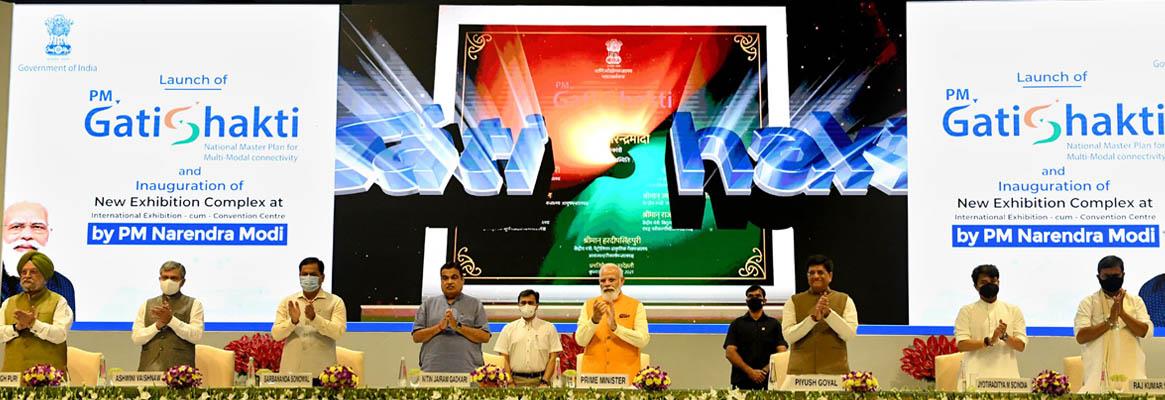Taking a giant stride towards its goal of achieving a $5 trillion economy, the Indian government has recently put the PM GatiShakti National Master Plan (NMP) in motion. By integrating the different modes of transportation, the plan aims to bring down the cost of logistics for businesses.
When Citi CEO Jane Fraser says, “I often point to India as the gold standard (emphasis added) when it comes to the shift to digital, and I think it will continue to be an important destination for investment from businesses across the globe,” she is not exaggerating. Fraser told this to none other than India’s finance minister Nirmala Sitharaman when they met in mid- October during the latter’s visit to New York.
The compliment from Fraser for a third-world country like India is based on the ongoing digital revolution that the country is witnessing over the last few years. Continuing with its policy of using digital tech for all-round progress, the Prime Minister Narendra Modi-led government has recently rolled out a national master plan that would transform the country’s logistics sector through multimodal connectivity (including digital mediums), which will bring down the cost of logistics for businesses and industries.
As part of the NMP, economic zones like textile clusters, pharmaceutical clusters, defence corridors, electronic parks, industrial corridors, fishing clusters, and agricultural zones will be covered to improve connectivity and make Indian businesses more competitive. It will also leverage technology extensively including spatial planning tools with ISRO imagery developed by BiSAG-N (Bhaskaracharya National Institute for Space Applications and Geoinformatics).
Launching the new plan on October 13, Modi said, “Under the PM GatiShakti National Master Plan, everything is being linked from roads to railways, from aviation to agriculture, various ministries and departments. A technology platform has also been prepared for every mega project so that every department has the right and accurate information on time.”
Terming the plan as an extension of holistic governance, Modi said, “The PM GatiShakti Master Plan not only seeks to bring together the government processes and its various stakeholders, but it also helps to integrate different modes of transportation.”
The multimodal connectivity will provide integrated and seamless connectivity for movement of people, goods and services from one mode of transport to another.
It will facilitate the last mile connectivity of infrastructure and also reduce travel time for people. PM GatiShakti (the Hindi words which translate to ‘SpeedPower’) will provide the public and business community, information regarding the upcoming connectivity projects, other business hubs, industrial areas and surrounding environment. This will enable the investors to plan their businesses at suitable locations leading to enhanced synergies. It will create multiple employment opportunities and give a boost to the economy. It will improve the global competitiveness of local products by cutting down the logistics costs and improving the supply chains, and also ensure proper linkages for local industry and consumers. A result of Modi’s constant endeavour to build next generation infrastructure which improves ‘Ease of Living’ as well as ‘Ease of Doing Business’, PM GatiShakti NMP will address the past issues through institutionalising holistic planning for stakeholders for major infrastructure projects. Instead of planning and designing separately in silos, the projects will be designed and executed with a common vision. It will incorporate the infrastructure schemes of various ministries and state governments like Bharatmala, Sagarmala, inland waterways, dry/land ports, UDAN (a regional airport development programmeof the Government of India), etc.
Key Points
• PM GatiShakti NMP is to be monitored in a three-tier system with an Empowered Group of Secretaries (EGoS) headed byCabinet Secretary at the top.
• A multimodal Network Planning Group (NPG) to be constituted with representation from the heads of Network Planning Division from various Ministries and Departments. The NPG will be supported by a Technical Support Unit (TSU) located in Logistics Division of Ministry of Commerce and Industry.
• It is set to be a game-changer in inter-ministerial and interdepartmental cooperation in infrastructure planning.
• It signals a paradigm shift in India’s approach to development planning.
• It will ensure maximum utilisation of resources and capacities, enhancing efficiency and reducing wastage.
• It will break Departmental silos and institutionalise holistic planning for stakeholders across major infrastructure projects. All Departments to now have visibility of each other’s projects through a centralised portal.
• It will provide multimodal, integrated and seamless connectivity for movement of people, goods and services.
• It will generate multiple employment opportunities, cut down of logistics cost, improve supply chains and make local goods globally competitive.
The Pillars
PM GatiShakti is based on six pillars:
1.Comprehensiveness: It will include all the existing and planned initiatives of various Ministries and Departments with one centralised portal. Each and every Department will now have visibility of each other’s activities providing critical data while planning and execution of projects in a comprehensive manner.
2. Prioritisation: Through this, different Departments will be able to prioritise their projects through cross-sectoral interactions.
3. Optimisation: The National Master Plan will assist different ministries in planning for projects after identification of critical gaps. For the transportation of the goods from one place to another, the plan will help in selecting the most optimum route in terms of time and cost.
4. Synchronisation: Individual Ministries and Departments often work in silos. There is lack of coordination in planning and implementation of the project resulting in delays. PM GatiShakti will help in synchronising the activities of each department, as well as of different layers of governance, in a holistic manner by ensuring coordination of work between them.
5. Analytical: The plan will provide the entire data at one place with GIS based spatial planning and analytical tools having 200 layers, enabling better visibility to the executing agency.
6. Dynamic: All Ministries and Departments will now be able to visualise, review and monitor the progress of cross-sectoral projects, through the GIS platform, as the satellite imagery will give on-ground progress periodically and progress of the projects will be updated on a regular basis on the portal. It will help in identifying the vital interventions for enhancing and updating the master plan.
This article was first published in the December 2021 edition of the print magazine.








Comments